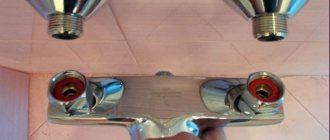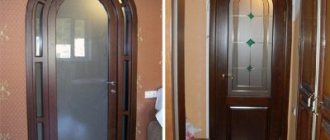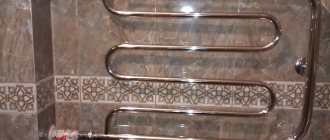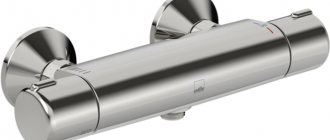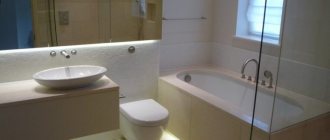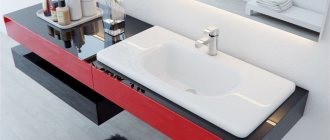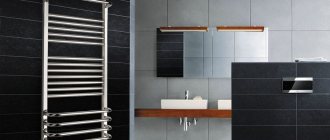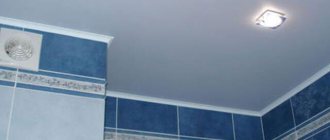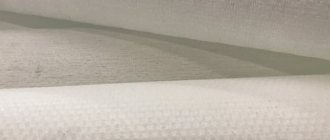Bathroom screens are rarely included with ordinary metal or cast iron bowls, as, for example, with acrylic ones. Therefore, the question arises: how and with what to close the space below, making the room and the bath itself more neat, comfortable and beautiful. A bath screen, of course, is not vital, but a very important functional and decorative element. It allows you to complete the decorative design of the room, hides various communications from view, and with a certain design allows you to use the space under the bathroom to store household small items.
The bathroom will look better if the space under the bathtub is covered with a decorative screen
There are actually a lot of ways to close a bathtub: from basic curtains or simple factory screens to stationary walls and complex podium structures. You should understand all the options and their features in order to choose the best one.
Ready-made screens
The most common and relatively inexpensive way to close a bathtub is to buy a ready-made factory screen. Most often they are made of plastic, but they can also be metal, glass, MDF or wood. The dimensions of the finished screens, as a rule, correspond to the standard parameters of bathtubs.
Plastic bath screen
Ready-made screen designs consist of one or more panels, which are enclosed in a metal or aluminum frame on legs. They are very easy to install.
It is enough to place the upper edge of the assembled panel under the side of the bath, align it to the floor at an angle of 90° and unscrew the adjustable support legs to fix the screen. No additional fixation is required, so they can be easily removed if necessary.
By design, screens are:
- Deaf;
- With sliding doors;
- With hinged doors;
- With drawers.
Blank screen for bathtub
Sealing and decoration options
It is worth noting that it is possible to hide the voids under the bathtub not only unilaterally, by tightly sealing the corresponding area.
A variety of cleaning products, powders and other accessories fit perfectly into the technological niche.
One of the most common and commonly used solutions is special screens. This design can be installed extremely easily and quickly.
In addition, there will be no problems or time-consuming tasks, unlike the construction of a concrete structure. Today you can purchase standard bath screens even in the store.
In addition, it is not difficult to make them yourself according to your own unique design, depending on the location, volume and design of a particular container, as well as the need to fill the space in the bathroom.
Installing the screen under the bathtub is also extremely simple. The presence of specialized spacers and adjustable legs greatly simplifies all work and eliminates the need to damage or dismantle external decorative materials and tiles.
Today there are a huge number of colors and variations of the corresponding screens. Plastic components perfectly combine reasonable cost, as well as high strength and attractiveness.
High temperature and humidity do not pose any problems for it, and therefore it can last for many years, provided that it is used carefully and there are no critical mechanical impacts.
It is quite possible to build a completely blank screen or make sliding doors that are not even visible at first glance.
It is always worth remembering that no one is insured against breakdown of communications, and no one needs to break concrete for a long time and sadly, risking damaging all the finished surfaces, and even the bath itself.
You can pay attention to screens that, in addition to well-thought-out frames, also have shelves inside. Several walls will provide complete encirclement of the space under the bathroom, providing a space that is aesthetically pleasing on the outside and useful on the inside.
The capital and completely static design is currently much less popular, although for only a couple of decades it was given absolute preference due to the lack of special alternatives.
In addition, you can paint such surfaces with acrylic or silicone waterproof paint, cover them with artificial stone, or simply stick on PVC film.
You can also use a wooden coating made from dies, which must be pre-treated with waterproof compounds. Many companies also complete their products with a plastic frame, which is installed simultaneously with the container itself.
As a result, such surfaces only need to be finished or painted on the outside to create a completely harmonious and attractive environment.
Nothing prevents the use of ordinary lightweight plastics, and even foam plastic, as covering panels.
However, any careless impact can lead to destruction and cracks, so preference is still given to more durable materials
Screens with sliding doors
Screens with sliding doors are considered the most convenient and functional option. Two, three or four door panels move along guides and, when opened, slide behind each other; less common are models where the screen folds like an accordion when opened.
Bath screen with sliding doors
When opened, such doors do not take up free space in the room, which is especially important in small bathrooms. In addition, they are convenient for storing various items under the bathroom and do not interfere with urgent repairs of communications located here.
Attention! Bath screens can be equipped with one or more doors, and they can also be single or double, when behind the hinged and sliding doors there is another screen in the form of niches and shelves, which allows you to conveniently place containers and other household items.
Tips and tricks for arrangement
In a small room, every corner needs to be used. The door can be converted into a hanger for towels and clothes. It is enough to screw the hooks or crossbar to it. You can even attach a small shelf for small items. It is advisable to choose a sink with a bedside table where cleaning products, rags, sponges and other things will be stored. If this is not possible, it is recommended to buy a basket where you can store household chemicals or put dirty things. The space under the sink should be used to the maximum because it is functional and adds coziness to the room. All bathroom cabinets should have 2 or 3 tiers to save space. The wall above the toilet, as a rule, is not used in any way, since there is a risk of hitting your head on objects.
However, you can attach a small shelf to it for storing cosmetics, towels and toilet paper. It’s convenient to hang towels on hooks in the wall, so they don’t take up much space and are easy to take. However, if there is no space on the walls, you can use baskets and racks. Towels easily fold into “rolls” and other shapes. You can make a beautiful composition out of them. This arrangement saves a lot of space. Every home has things that are used very rarely: spare towels, household cleaning chemicals, a first aid kit, etc. You can store them on high shelves when there is no more space left on the floor and walls. They will not clutter up the space, and storage will become more convenient.
A mirror in the bathroom is an important attribute. In stores you can find models with opening shelves. The mirror plays the role of a door. Inside you can place cosmetics and household chemicals. A good solution would be to screw shelves on the sides of the mirror. To prevent cosmetics from lying everywhere, it is best to purchase an organizer or make one yourself. You can place shelves in the corner of the room. They won’t fit many items, but it’s better to add several levels for greater functionality. Placing furniture in the bathroom can be challenging due to the small space. Periodically, it is worth doing general cleaning and throwing away unnecessary things.
Screen with hinged doors
Allows easy access to communications located under the bathroom, as well as storing detergents and cleaning products here. It differs from others, in fact, only in the way the doors open. Wooden models or MDF screens look especially interesting, but this option is not always convenient in tight spaces.
Screen with hinged doors made of wood
The nuances of gluing tiles
Sequence of actions and nuances when installing tiles:
- Prepare a portion of mortar for gluing tiles. The adhesive mixture is mixed using a hand mixer in a separate container in accordance with the manufacturer's recommendations. If the tiles are laid on a plastic or wooden base (for example, a sheet of plywood), then sealant or liquid nails are used for fixation.
- Find the vertical axis of symmetry of the screen, and then calculate the number of tiles required to lay the first row.
- Trim the edge tile according to the calculated size.
- Start covering the screen from the bottom corner located on the side without the inspection window. The adhesive is applied only to the tiles; a notched trowel is used to distribute the mass.
- Place the element on the wall, controlling the position using a 400-450 mm long building level. To adjust the position of the tiles relative to the floor covering, plastic wedges are used.
- By analogy, attach the adjacent element; plastic crosses are placed in the gap between the tiles to regulate the width of the gap. The tiles around the viewing window are cut using an abrasive tool.
- After laying the tiles, you must wait 24 hours for the water from the adhesive to evaporate. Then the joints are filled with grout paste with the addition of an antifungal additive. The grout is introduced into the cavities using a rubber spatula, the excess is removed from the surface of the tile with a damp sponge (15-20 minutes after application).
Stationary screens
Capital or stationary wall screens are non-demountable structures that block free access to the entire space under the bathroom. They represent a base that requires additional finishing.
Screens do:
- Brick;
- chipboard;
- Plywood;
- Moisture-resistant drywall;
- Boards
A screen lined with tiles.
Such a capital device requires subsequent finishing or cladding; for this use:
- Tiles;
- Mosaic;
- PVC film or panels;
- Fake diamond;
- Paint;
- Wood finishing;
Capital brick screens
A reliable brick foundation is inexpensive and, perhaps, the simplest of all options. The construction of the screen involves laying half a brick on cement mortar in a dressing. Next, the structure is covered with tiles or any other available material. Minor curvatures of the masonry can be easily corrected by increasing or decreasing the amount of tile adhesive layer.
Capital brick screen for bathtub Important! When installing a screen wall, you should always leave a technological hole for quick access to pipes and eliminating leaks.
Bath podium
Of course, this option is only suitable for spacious bathrooms. The sizes and designs of podiums can be very diverse and are limited only by the imagination of the owners. The base for the podium is usually laid out of brick, and tiles or mosaics are used as finishing. It is important that the finishing of the steps of the structure has an anti-slip coating.
Bath podium
Decorative curtain
A curtain is the fastest and most inexpensive way to hide all the imperfections of your plumbing. In addition, it is easy to store household items under it. To make a curtain, just select a suitable piece of fabric and stitch it around the perimeter; if the fabric is thick, you can make folds or do without them.
Decorative curtain for the bath
There are several ways to attach the curtain, the simplest is to use double-sided Velcro tape. One side is attached directly to the curtain, and the other is glued with liquid nails under the rim of the bathtub. You can also use a thin furniture pipe with fasteners, to which the curtain is tied using loops.
Important! When choosing a bath screen, you should also consider the style of the interior. For country, a curtain would be an excellent option, while for modern, a metal screen would be more preferable.
Material for making screens
For taps, you should select only moisture-resistant materials that can easily withstand steam and constant temperature changes.
- Screens made of plastic panels are the simplest, inexpensive and most common option. The material is quite practical, not afraid of moisture and easy to care for.
- MDF screens are made only if the wood fiber board is treated with a special water-repellent agent, this makes it impervious to prolonged contact with water.
Mirror screen for bath
- In addition to plastic, screens are made of glass, frosted or transparent, smooth or with a textured surface. Glass can be painted in any shade, sometimes a pattern is applied to it.
- Decorative mirror screens will fit well into any interior and visually increase the size of the room.
To make a screen for a bathtub with your own hands, you must first build a frame from a profile or wood. Also, polystyrene foam or brickwork can serve as a base. When the frame is ready, it is sheathed with the selected material or tiled.
How to make a bathtub screen with your own hands: video
Screen under the bath: photo
What should a good curtain be like?
For all types of bathtubs, curtains are a must-have accessory, otherwise the floor and walls in the room will constantly be wet.
Curtains in the bathroom help to preserve the renovation for a long time, protect the bathtub from fungus and mold, and make the room cozy and beautiful. In order for a product to cope with its purpose, you need to choose it wisely.
Classic curtains
Classic models are very similar to window curtains - a curtain made of a special material is attached with rings to a flat or tubular cornice.
But there are also some differences from ordinary curtains: such a cornice is attached to the spacer between two parallel walls, and only material that has been previously impregnated with a special waterproofing substance can be used as a curtain.
Classic curtains can be created with your own hands without much difficulty.
Flexible curtains for the bathroom are made from the following materials:
- polyethylene;
- linen or cotton with impregnation;
- vinyl;
- polyester.
The cornice can have a straight or curved shape, depending on the configuration of the bathtub. A tubular cornice-spacer is suitable for a straight bathtub.
If the bathtub bowl is curved, then the supporting structure is the ceiling profile, which can be of any shape. However, such products have both advantages and disadvantages.
The most important advantages are:
- Low cost. Such curtains do not need to be cleaned of dirt, but simply replaced with new ones if necessary.
- Quick interior update. By changing the curtains, you can transform your bathroom in a matter of minutes.
Like any inexpensive accessory, cheap canvases have their drawbacks:
- Short service life. Even if you take good care of the product, it will not last longer than a couple of years.
- Rapid contamination. Inexpensive materials become covered with rust stains, deposits of mineral salts, and colonies of mold fungi appear on them. At the same time, when washing or cleaning, there is a possibility that the product will lose its presentable appearance.
Classic curtains are sold in supermarkets, construction markets and specialized boutiques of bath products. In addition to ready-made curtains, hand-made materials are also sold there.
Sliding curtains
The sliding structure is installed on the edges of the bathtub. Its main advantage is that it takes up very little space. And the main disadvantage is the visual reduction of space. Sliding curtains are perfect for a spacious bathroom.
There are 2 most popular types of sliding curtains:
- glass;
- plastic.
In terms of functionality and aesthetics, the models do not have significant differences; the difference lies in the price and care features.
It is possible to assemble such a structure with your own hands, but it will take a lot of time and effort.
Folding curtains
Folding structures, also called accordions, are removed with one hand.
Folding curtains consist of fabric sheets of the same size, stretched over narrow frames
The movement of the structure occurs due to the hinge system, so when choosing, you need to pay attention to the strength and quality of the joints
Doing such a thing with your own hands is very troublesome and time-consuming, and you will also need the skill of sewing and constructing from metal or PVC profiles.
Hinged and corner curtains
Judging by the reviews, the swing design is the most inconvenient. To open such a curtain, you need to have a lot of free space. But for shower cabins without a tray, a swing curtain will be the best option.
Thanks to the waterproof fabric, you can better protect the room from moisture. To cover the corners that remain open, a convenient door is installed. With its help you can organize a completely enclosed space.
Acrylic sheets are usually used to make corner curtains. You can make such a thing with your own hands, but you will need engineering thinking and accurate calculations of materials and fasteners.


